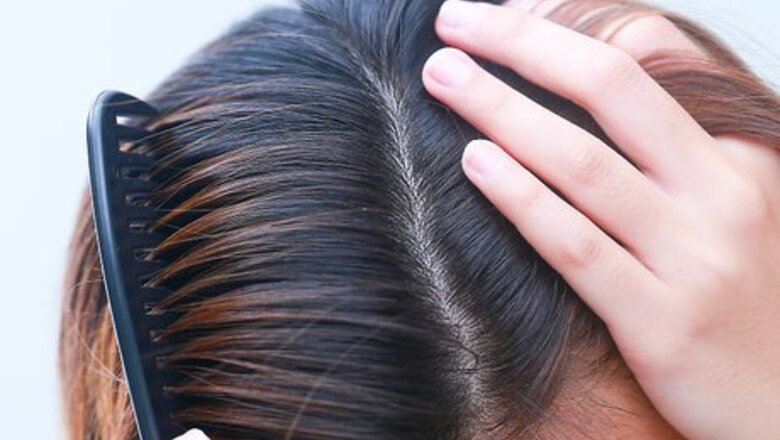
views
Creating a Simple Side Braid
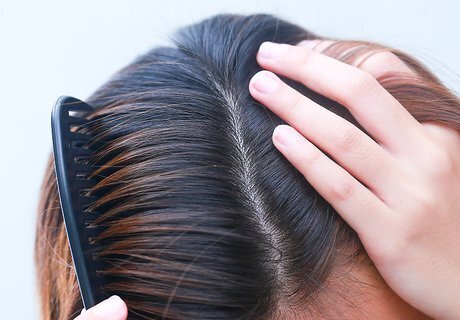
Part your hair down the center. Use a comb to draw a part down the center of your hairline. Brush the hair flat on either side of this part. For this style, you'll need to create two standard braids along the front sides of your head. These braids should roughly mirror one another in position, width, and length. This style is good for very short hair, as you can decide to braid only a portion of your short hair if you do not have enough hair to put it all back in a braid. EXPERT TIP Ndeye Anta Niang Ndeye Anta Niang Professional Hair Stylist & Master Braider Ndeye Anta Niang is a Hair Stylist, Master Braider, and Founder of AntaBraids, a traveling braiding service based in New York City. Ndeye has over 20 years of experience in African hair including braiding box braids, Senegalese twists, crochet braids, faux dread locs, goddess locs, kinky twists, and lakhass braids. Ndeye was the first female of her tribe in Africa to move to America and is now sharing her knowledge of African braids passed on from generation to generation. Ndeye Anta Niang Ndeye Anta Niang Professional Hair Stylist & Master Braider Expert Trick: Start by washing, deep conditioning, and detangling your hair. Once it's dry, section your hair for the braids. If your hair is kinky and it tangles quickly, put the sections in small ponytails, or you can just leave them down if it usually stays detangled.
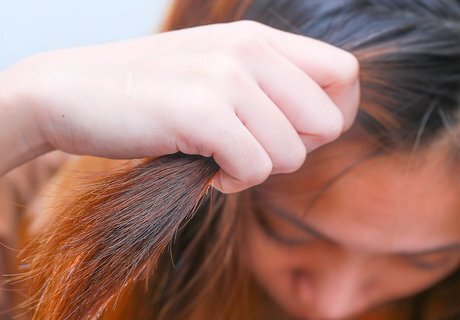
Grab a section of hair on the right. Gather approximately 3 inches (7.6 cm) of hair toward the front of your face, working to the right of the part. If you have short bangs that you wish to keep out of the braid, begin the section immediately behind the right end of your bangs. If you have long bangs that you want to include in the braid, split the bangs in half down the center. Include the right half of your bangs in this first section and the left half of your bangs in the second section.

Divide the section into three portions. Split the gathered section of hair into three portions. Try to make each portion equal in length and width.
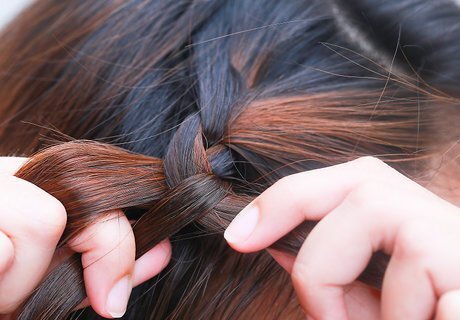
Braid the portions together. Braid the three separated portions into a standard braid. Direct the braid so that it points down and toward the back of your ear. Cross the left portion of hair over the middle section. The previous left portion now becomes the new middle portion. Cross the right portion over the new middle portion to complete one full braid. Repeat as many times as needed until the braid reaches your desired length.
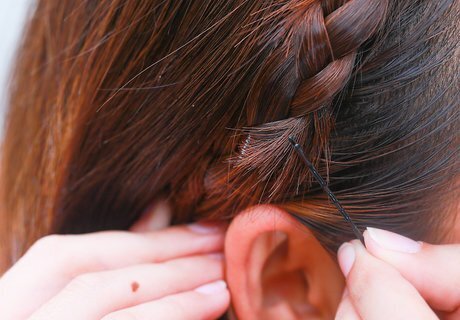
Tie and pin the braid in place. Tie the end of the braid with a small hair elastic, then use a bobby pin the tack the loose end to the unbraided hair at the side of your head.

Repeat on the left. Create an identical braid on the left side of your part by following the same steps used to create the first braid. Separate the section into three portions, then braid those portions down toward the back of your ear. Note that the two braids don't need to be exactly identical, but they should look very similar to one another to maintain enough symmetry.
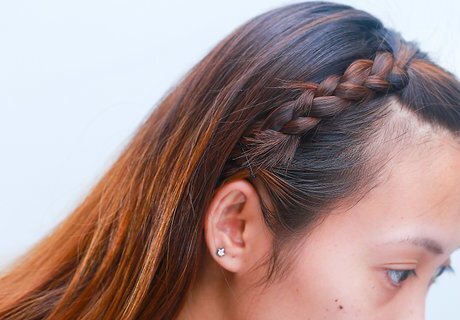
Flaunt your braids. Check your braids in the mirror and redo them if necessary. Once they look the way you want them to look, the style is done and ready to show off.
Styling a Waterfall Braid
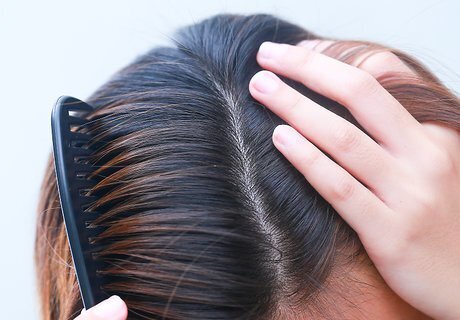
Part your hair along the side. Use a comb to draw your part along either side of your head. Brush the hair on both sides of this part to keep it smooth. To create this look, you'll create a partial French braid that drapes down along one side of your head. As you form the braid, though, you'll leave some hair hanging down from beneath it, creating a “waterfall” effect. This style may be better for individuals with short hair that comes to at least their shoulders or just above their shoulders. Alternatively, if your hair is very short you can try to do a waterfall braid on a section of your hair, not your entire head.
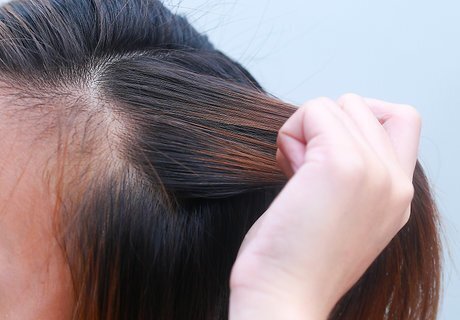
Grab a section of hair. Gather approximately 2 inches (5 cm) of hair toward the front of your face. This section of hair should be taken from the wider side of your part. If you have long, sideswept bangs, your first section of hair will mostly consist of your bangs. If not, draw the section from the hair closest to your part and at the front of your face.

Create a few braids from this section. Split the section of hair into three equal portions, then braid those portions together into one or two full braids. To form a single braid, cross the left portion of hair over the middle portion, then cross the right portion of hair over the new middle portion (previous left portion).
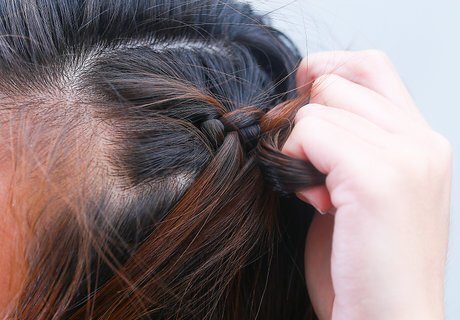
Gather new hair into the braid. Gather a new portion of hair into the braid by drawing it from the top of your head.You'll add this hair to your braid using a traditional French braiding technique. Pick up a section of hair directly next to the topmost section of your braid. The section should be roughly one-third as thick as the overall braid. Draw the new portion together with the current topmost piece, essentially forming one large portion. Create another single braid using this newly joined portion of hair.
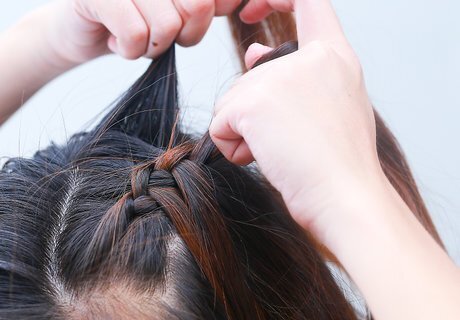
Pick up a new section from the bottom. Gather a new portion of hair into the braid from beneath. Instead of incorporating it into a standard French braid, however, you'll use this new section as a substitute for an old section. Pick up the second new portion will from directly beneath and behind the braid. Draw together a portion of hair roughly one-third as thick as the overall braid. Drop the current bottom portion of the the braid and allow it to hang loose down the side of your head. Create one new braid using the new bottom portion. Leave the previous bottom portion alone.
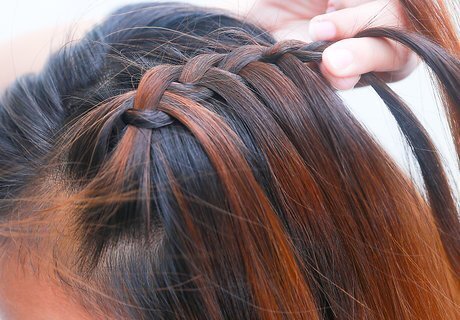
Repeat to desired length. Continue drawing new hair into the braid using the same technique as before. Braid the hair in this manner until you reach the back of your head. Each new portion of hair taken from above the braid should be woven into the braid with the previous top portion. Each new portion of hair taken from beneath the braid should be woven into the braid instead of the previous bottom portion.
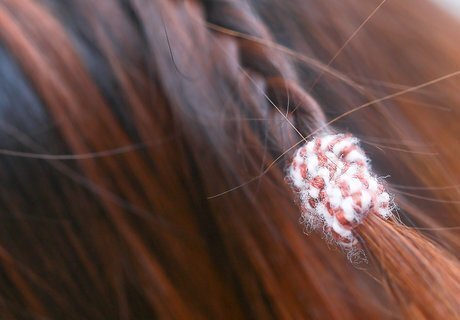
Secure the braid. Tie the loose end of the braid off with a small elastic hair band. Allow the loose ends to hang down naturally off the back of your head. Carefully brush the loose hair hanging from beneath your braid to remove any tangles and smooth out any frizz.
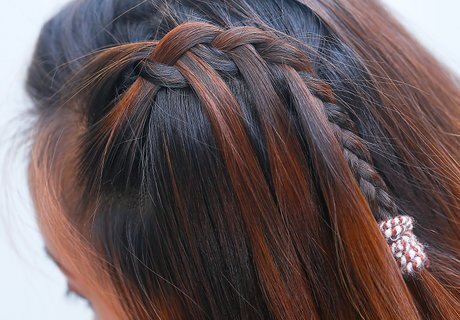
Sport your new braid. Check your braid in the mirror. If you like the way it looks, the braid is done and ready to show off. If not, unbraid and redo until you have the desired look.
Doing a Halo Braid
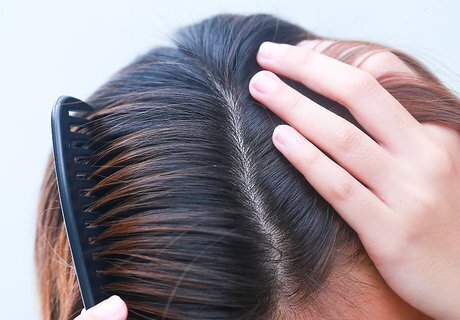
Part the hair. Draw your desired part using a comb. This style works with both center and side parts alike. Regardless of which part you choose, brush your hair flat on either side of the part after defining it. For this style, you'll create one French braid on either side of the part and along the lower hairline. Afterward, you'll secure the two braids together, forming the shape of a crown. This style is also known as an “around the world” braid. This style may be best for individuals with short hair that is at least to their shoulders or above their shoulders as it works best with more hair.
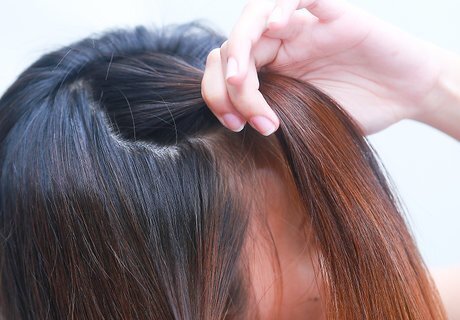
Pick up three portions of hair. Gather together three sections of hair along one side of your part. These sections should be roughly equal in length and width. Each section should be about 1 inch (5 cm) wide. If you have long bangs, the front section will include hair from your bangs.
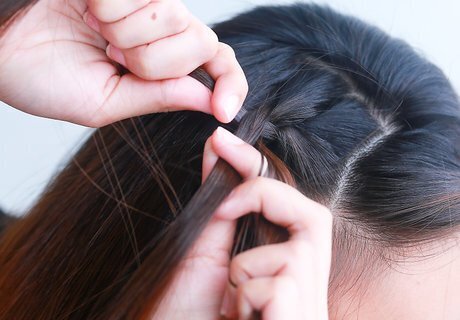
Braid the sections together. Create one or two full standard braids from your original three sections of hair. A single full braid includes all three sections of hair. Cross the back portion over the middle, turning the previous back portion into the new middle in the process. Complete the braid by crossing the front portion over the new middle, turning the front into the newest middle.
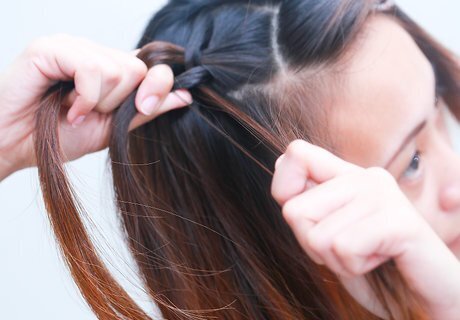
Gather new hair into a French braid. Draw two new portions of hair into the current braid. Create one full braid with each new section to begin your French braid. The first new section should come from the top of your head and further back along your part. Combine this new section with the current topmost section of your braid, then create one new braid using the newly combined portion. The second new section should come from in front of your braid and just beneath it. Combine this section into the current bottom section of the braid, then create one new braid using the combined portion.
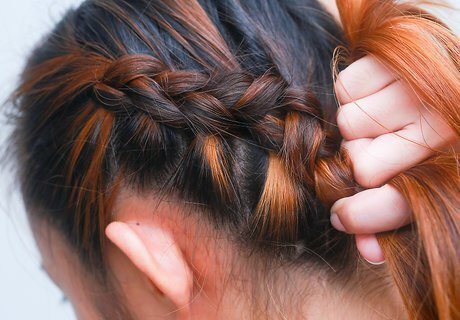
Repeat around the hairline. Continue French braiding down the side of your head. Work around the entire lower hairline, drawing in all of the hair from beneath your braid as you do. Pay special attention to the hair around your ear. This hair will need to be braided tightly to create the most flattering appearance possible.
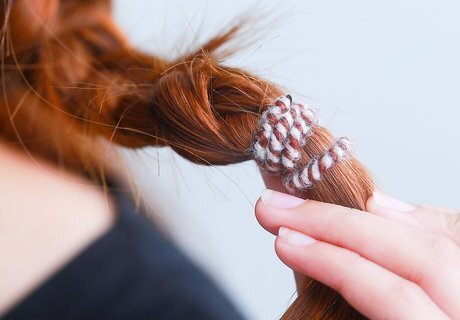
Braid down the loose ends. Once you reach the center back of your head, braid any remaining loose hair on that side into a standard braid. Tie off the end with a small hair elastic.
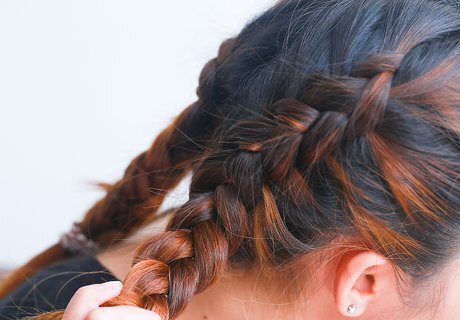
Repeat on the other side. Braid the hair at the other side of your part by following the same steps used for your first braid. Pick up three equal portions of hair along the other side of your part. French braid the hair on the opposite side of your head, leaving no loose-hanging hair in the process. Continue along the lower hairline in this manner. Braid down as much of the loose ends as possible into a standard braid, then secure the end with an elastic hair tie.

Tuck in the ends. Crisscross the hanging ends, then tuck them beneath the braids to hide them from view. Depending on how tight your braids are, tucking in the ends can be a difficult challenge. Work carefully to avoid pulling out the braid, and hide the unbraided ends and hair ties as best as possible. Note that you'll probably need to insert a few bobby pins through the tucked ends to help hold them in place.
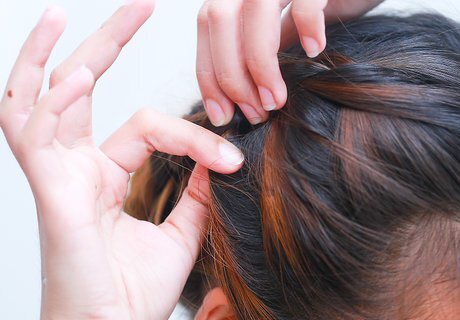
Add volume to the braid. Use your fingers or the handle of a rat-tail comb to carefully pick up and loosen each individual braid. Only pull on each braid enough to give it a little more body. Do not pull hard enough to completely undo the braid. Skip over the sides and focus on the front and back of the braid. Doing so will add volume to the braid without sacrificing an appealing face shape.

Adjust and enjoy. Check your halo braid in the mirror and make any desired adjustments. Once you're satisfied with the way it looks, you should be ready to show it off. If the top of your head looks too flat or slick, carefully swipe your hand over the hair, working it back and forth several times. Doing so should gently loosen and volumize the hair there, making it messy and natural without destroying the braid.
Braiding Afro-Textured Hair

Use hair oil before you braid. To make styling easier, you should use natural hair oil on your scalp and massage the oil into your hair. Use natural oils like jojoba or coconut and avoid heavy oils like lanolin, petroleum, and mineral oils. These oils will clog up your scalp and attract dirt and dust. You can also use a boar bristle brush to brush the oil into your hair to make it easier to braid. If you have very thick, afro-textured hair, you can skip this step as it can make your hair more frizzy.
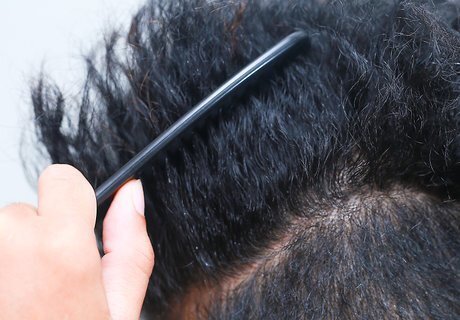
Braid your hair in sections. It will be easier to work with your hair if you divide it into sections using a rat-tail comb. Divide your hair into two sections and clip each section with a hair clip. You can then focus on one section at a time. You can then decide if you are going to do simple braids where you braid each section into simple braids, creating two side braids or a more elaborate design like a top mohawk with braids.

Do side braids. This is an easy option for afro-textured hair as it only requires you to know how to do simple braids. Because afro-textured hair can be very thick and tricky to work with, many people do small side braids in a row rather than two big side braids. Start with one section and do a small braid with 1/4 of the hair on one side. Start the braid just above your ear, at the top of your hairline. Collect hair as you braid, forming a small braid that lies flat against your scalp. Pull the hair so it is taunt but not too hard, as you do not want to damage your hair or your scalp. Once the braid is done, use a bobby pin to secure it. Then, make another small braid above the braid you just created. Make sure the braid starts right at your hair line and is parallel to the first braid. Secure this braid with a bobby pin. Finish with one more small braid above the second braid. It should start at your hair line and move parallel to the second braid. There should now be three braids on one side of your hair, forming diagonal lines. Repeat these steps on the other side of your head. You should now how small braids on either side of your head, framing the rest of your hair. You can then leave the rest of your hair natural or finger curl it using your fingers and hair oil.
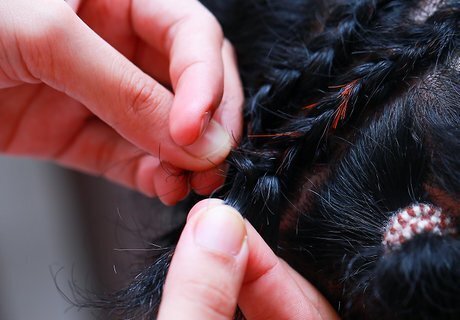
Try a top mohawk with braids. This option is a more elaborate braided hair style and may require a second set of hands or help from a professional hair dresser who knows how to work with afro-textured hair. If you are experienced with braiding your hair type, you may be able to do this one at home. Divide your hair into four sections and pin each section with a hair clip. Then, unclip the section at the front end of your hair, right above your ear. You will then braid a small section of the hair above your hair moving upward. Pull the hair taunt but not too tight as you braid upward. You want the braids to be as vertical as possible. When you reach the top of your head, pin the braid and then let the rest of your hair sit on your head. Move on to braid the next small section of the front section of your hair. Make the braid vertical and tight, leaving the remaining hair from the braid loose once you reach the top of your head. Repeat these steps, moving from section to section of your hair. The braids should all be vertical and in line with each other. Keep the hair at the end of the braids lose and let it sit on your head. This hair will act as the top mohawk. Once you have finished braiding your hair into vertical braids, you should have a row of 9-10 braids on each side of your head. You can then style the mohawk using hair oil and your fingers for a fun look.



















Comments
0 comment